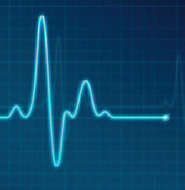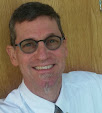Why We Broke Up by Daniel Handler
New York : Little, Brown, 2011.
354 p. : col. ill. ; 22 cm.
A really lovely book, that offers several creatively fresh angles on the romance that falls apart between two unlikely teens.
The first nice hook of this book is the premise. The book is the supposed text accompanying the box of returned "artifacts" of this couple's brief love affair which is being ended by the girl after she learns of her boyfriend's secret second girlfriend.
The next appealing aspect of the book are the lovely full color paintings by Maira Kalman which begin each chapter of the book - usually being a chapter describing one item in the box and how it relates to the couple's romance and break-up. These illustrations (like the one at the top of this entry) are simple - but wonderfully colorful and evocative. They also serve to stoke the reader's curiosity and add texture to the novel. I often found myself gazing at them before beginning a chapter, and then looking back at them after reading the chapter.
Another strength of this book are the characters, who are richly developed and complicated. Min Green, the girl who tells the story, is smart, irreverent, artsy and - unfortunately - naive. Her boyfriend the popular, good looking Ed Slaterton is a jock and a bit of a cad, but is also very smart in math and clever and funny.
If I had a complaint for this book, it would be that it was a bit too long. I felt like it lost its pace about 2/3 of the way through, and like other critics of the book I found myself being a bit annoyed with the narrator - her obsession with films and inability to see the flaws of her boyfriend get tiresome toward the end. However, I felt like the book found its footing toward the end and I would definitely recommend it to any student looking for a book about dating, romance, first love, and break-ups.
For me this book called to mind Chbosky's Perks of Being a Wallflower and Cohn's Nick and Norah's Infinite Playlist.
Tuesday, May 21, 2013
Tuesday, May 14, 2013
The One I Couldn't Read
Marked by P.C. and Kristin Cast
New York : St. Martin's Griffin, c2007.
306 p. ; 21 cm.
What can I say about this book? It's a hot mess of a work - sloppy, uneven, awfully plotted, silly dialogue, boring, unoriginal...and extremely popular - sigh. It is a book that successfully takes advantage of the vampire phenomenon but is such a mix of high and low (pretentious references to myth and American Indian "lore" along with crass commercialism and sexuality) and poor writing that I just could never lose myself in it. Unlike the Twilight series- where I didn't care for the plot and characters - but could appreciate the strong writing and structure of the book, this one just left me completely unsatisfied.
I really tried to give it a go, but around page 125, I signed the papers and pulled the plug (something I almost never do with a book I've started). I just couldn't take anymore lines like the following when the main character sees a "hot" young man at her new vampire school:
And that was one of the better passages of the book. I guess this book and the series it launched (The House of Night series) proves that reading is an incredibly subjective endeavor - even just reading for entertainment. I'm not above reading a book for light fun, but this one just didn't do it for me.
New York : St. Martin's Griffin, c2007.
306 p. ; 21 cm.
What can I say about this book? It's a hot mess of a work - sloppy, uneven, awfully plotted, silly dialogue, boring, unoriginal...and extremely popular - sigh. It is a book that successfully takes advantage of the vampire phenomenon but is such a mix of high and low (pretentious references to myth and American Indian "lore" along with crass commercialism and sexuality) and poor writing that I just could never lose myself in it. Unlike the Twilight series- where I didn't care for the plot and characters - but could appreciate the strong writing and structure of the book, this one just left me completely unsatisfied.
I really tried to give it a go, but around page 125, I signed the papers and pulled the plug (something I almost never do with a book I've started). I just couldn't take anymore lines like the following when the main character sees a "hot" young man at her new vampire school:
"The door opened and oh my dear sweet lord I do believe my heart totally stopped beating. I'm positive my mouth flopped open like a moron. He was the most gorgeous young lad I had ever seen. He was tall and had dark hair that did that adorably perfect Superman curl thing. His eyes were an amazing sapphire blue and..." (p112)
And that was one of the better passages of the book. I guess this book and the series it launched (The House of Night series) proves that reading is an incredibly subjective endeavor - even just reading for entertainment. I'm not above reading a book for light fun, but this one just didn't do it for me.
Wednesday, May 8, 2013
Yum
New York : Penguin Press, 2006.
450 p. ; 25 cm.
I've been wanting to read Michael Pollan's book for quite a while, probably since hearing him interviewed on radio (or TV) back in 2006 when the book first came out. I remember being most intrigued by his findings that, thanks to the industrialization of food, corn has become the basis for nearly all food in the US, and that what is sold as "food" is often a chemically assembled/reassembled mix of corn, fats, salts, sugars, and "natural" flavorings that are rarely healthy or nutritious. Well, living in Illinois - the land of corn - (OK, coming in 2nd place to Iowa) and the home of the villainous "food" giant ADM and "food" behemoth McDonald's, I simply had to read Pollan's book. I wasn't disappointed.
Pollan's book is an interesting read on many counts - as science, natural history, social history, and culture. It is a book that offers a rare glimpse into the extremely destructive nature of agriculture/agribusiness as it is practiced in the US - and the many ways that the worst practices of agriculture (monoculture and complete dependence on fossil fuel) are encouraged and enforced by US law and policy.
His book also looks at agricultural practices that are beneficial to humans and the environment - including the importance of local foods. As a mostly vegetarian eater, I really appreciated his interesting insights into what is good and bad about the "organic" food supply as it has evolved in the US, particularly as it has become a huge multi-billion dollar industry itself. I also found a lot to think about regarding the positive benefits of having livestock on farms - livestock that are allowed to pasture and participate in a rich multi-cultured farm, not livestock that are raised in large-scale confinement operations.
For the leisurely non-fiction reader, the book is a bit on the long side and took me awhile to finish, but I was really pleased when I realized that our library also has an edition of the book for younger readers (still weighs in at about 300 pages) that is really excellent. The young reader's edition has a lot of great photographs and graphics that frankly would have been wonderful in the adult version, so I can definitely recommend it as well.
Subscribe to:
Comments (Atom)



